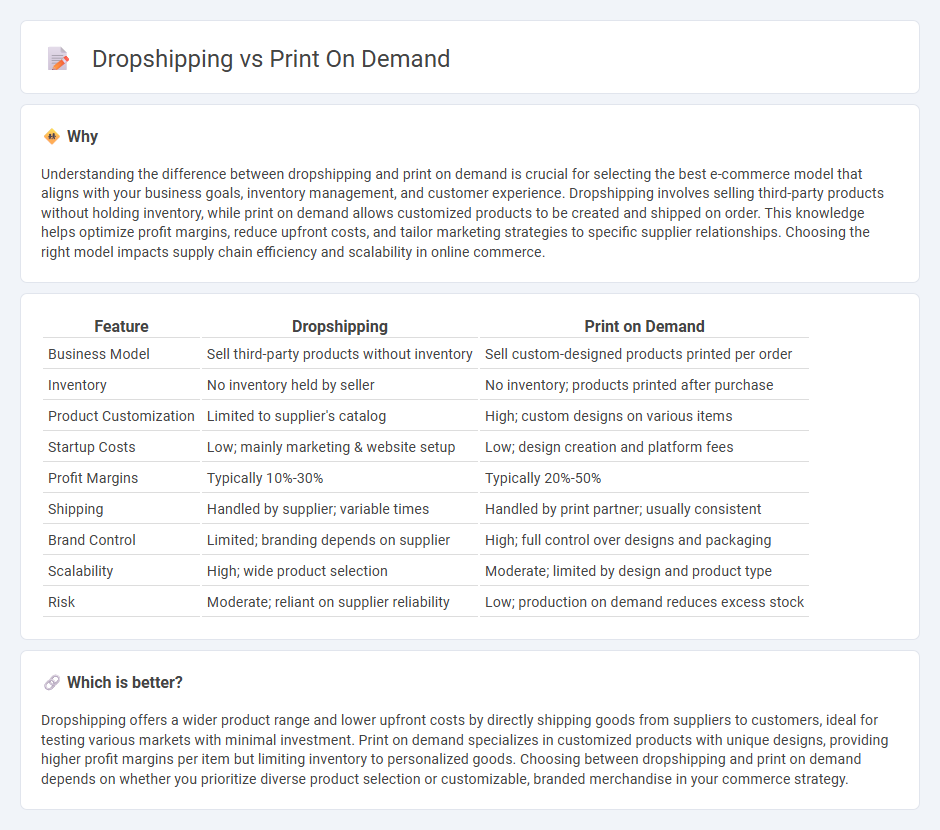
Dropshipping and print on demand are popular e-commerce business models that minimize upfront inventory costs by directly shipping products from suppliers to customers or printing items on demand. While dropshipping offers a vast range of products without inventory management, print on demand focuses on customized merchandise with scalable personalization opportunities. Explore the benefits and challenges of each to determine the ideal solution for your online retail strategy.
Why it is important
Understanding the difference between dropshipping and print on demand is crucial for selecting the best e-commerce model that aligns with your business goals, inventory management, and customer experience. Dropshipping involves selling third-party products without holding inventory, while print on demand allows customized products to be created and shipped on order. This knowledge helps optimize profit margins, reduce upfront costs, and tailor marketing strategies to specific supplier relationships. Choosing the right model impacts supply chain efficiency and scalability in online commerce.
Comparison Table
| Feature | Dropshipping | Print on Demand |
|---|---|---|
| Business Model | Sell third-party products without inventory | Sell custom-designed products printed per order |
| Inventory | No inventory held by seller | No inventory; products printed after purchase |
| Product Customization | Limited to supplier's catalog | High; custom designs on various items |
| Startup Costs | Low; mainly marketing & website setup | Low; design creation and platform fees |
| Profit Margins | Typically 10%-30% | Typically 20%-50% |
| Shipping | Handled by supplier; variable times | Handled by print partner; usually consistent |
| Brand Control | Limited; branding depends on supplier | High; full control over designs and packaging |
| Scalability | High; wide product selection | Moderate; limited by design and product type |
| Risk | Moderate; reliant on supplier reliability | Low; production on demand reduces excess stock |
Which is better?
Dropshipping offers a wider product range and lower upfront costs by directly shipping goods from suppliers to customers, ideal for testing various markets with minimal investment. Print on demand specializes in customized products with unique designs, providing higher profit margins per item but limiting inventory to personalized goods. Choosing between dropshipping and print on demand depends on whether you prioritize diverse product selection or customizable, branded merchandise in your commerce strategy.
Connection
Dropshipping and print on demand are interconnected e-commerce models that enable entrepreneurs to sell products without holding inventory or handling fulfillment. Both rely on third-party suppliers to manufacture and ship items directly to customers, reducing upfront costs and risks. This synergy allows businesses to offer customized merchandise efficiently while maintaining scalable operations.
Key Terms
Inventory Management
Print on demand minimizes inventory risks by producing items only after a customer places an order, eliminating the need for stock storage and reducing upfront costs. Dropshipping relies on third-party suppliers to fulfill orders directly, requiring close coordination to avoid stockouts and ensure timely delivery. Explore detailed strategies to optimize inventory management in both models for your e-commerce success.
Fulfillment Process
The fulfillment process for print on demand involves creating and shipping customized products only after a customer places an order, reducing inventory risks and storage costs. Dropshipping fulfillment relies on third-party suppliers who stock and ship a wide variety of products directly to the customer, allowing merchants to avoid holding inventory but often with longer delivery times. Explore more about how these fulfillment methods impact your e-commerce efficiency and customer satisfaction.
Product Customization
Print on demand offers extensive product customization by allowing designs to be tailored directly onto products, enabling unique and personalized items for customers. Dropshipping typically involves pre-made items with limited or no customization options, focusing more on inventory management and shipping logistics. Explore how product customization impacts your business model to choose the best fit for your e-commerce strategy.
Source and External Links
What Is Print on Demand and How To Start a Business (2025) - Print on demand is a business model where sellers create designs that suppliers produce only after a customer places an order, eliminating inventory and upfront costs while enabling selling across various products like apparel and home goods.
Print on Demand for Individuals and Brands | 370+ Products - Print-on-demand services allow entrepreneurs and creators to sell custom products worldwide with no inventory or logistics, offering product printing, packaging, and direct shipping once an order is placed.
Print on Demand & DropShipping Platform | 1000+ products - Printify - Printify provides a free, easy-to-use platform where anyone can sell custom printed products without upfront investment or fulfillment duties, suitable for creators, entrepreneurs, and brands looking to scale.
 dowidth.com
dowidth.com